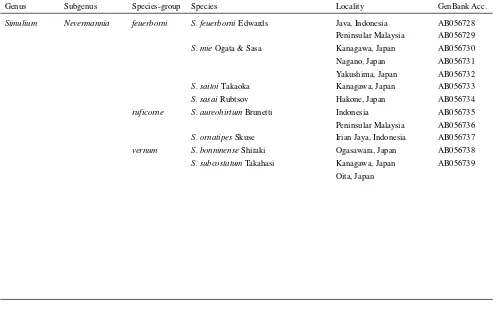PHYLOGENETIC ANALYSES OF A BLACKFLY SUBGENUS
SIMULIUM
(
NEVERMANNIA
) BASED ON MITOCHONDRIAL
16S RIBOSOMAL RNA GENE SEQUENCES
YASUSHIOTSUKA1, C
HIHARUAOKI1, K
ATSUMISAITO2, U
PIKK. HADI3, HIROSHISUZUKI4
ANDHIROYUKITAKAOKA1 ,* Received April 2, 2001/Accepted May 20, 2001
Abstract:Nucleotide sequences of a subregion of the mitochondrial 16S ribosomal RNA gene of 10 species of a blackfly subgenusSimulium(Nevermannia), which include four species offeuerbornispecies-group, two species ofruficorne species-group, three species ofvernumspecies-group and an ungrouped species (S. konoi), were de-termined. Phylogenetic analyses of the sequences of theNevermanniaspecies and other species of related subgen-era ofSimuliums.l. showed that thefeuerborniandvernumspecies-groups were closely related, but theruficorne
species-group andS. konoiwere not. Variations between theruficornespecies-group and otherNevermannia spe-cies were larger than those betweenNevermannia species (excluding theruficorne species-group) and other sub-genera species. These molecular data suggest that revision of the definition of the subgenus Nevermannia is needed.
Key words:Black fly,Simulium,Nevermannia, Phylogeny, Mitochondrial rRNA
INTRODUCTION
A blackfly subgenusSimulium (Nevermannia) is dis-tributed worldwide. In Asia, there are 3 species-groups (i.e.
feuerborni,ruficorneandvernumspecies-group), and some
ungrouped species (Crosskey and Howard, 1997). To inves-tigate the relationship within subgenus Nevermannia spe-cies and between subgenusNevermannia and other subgen-era, we analyzed sequence variations in a subregion of the mitochondrial 16S ribosomal RNA (rRNA) gene of 10 spe-cies of subgenusNevermanniaand related species.
MATERIALS ANDMETHODS
Materials used in this study and their origin are listed in Table 1. Total DNA was extracted from single larva us-ing the crude STE boilus-ing method (O’Neill et al., 1992). Polymerase chain reactions (PCR) were performed in a 50 µl reaction mixture using 2 µl of the DNA solution. The primers (primer A, 5’-CGCCTGTTTATCAAAAACA-T-3’; primer B, 5’-CTCCGGTTTGAACTCAGATC-3’) were used to amplify the mitochondrial 16S rRNA region as described by Xiong and Kocher (1991). The reaction
mix-ture contained 10 mM Tris (pH 8.3), 1.5 mM MgCl2, 50 mM KCl, 250 µM dNTPs, 2.5 units of Tag DNA polym-erase and 50 pM of each of the primers. The thermal cy-cling conditions were 35 cycles of denaturation at 95 DNA sequencing system (Promega). Sequences were
de-posited in DDBJ/EMBL/GenBank databases under acces-sion numbers AB056728-AB056747.
The sequences were aligned by using the program CLUSTAL W ver. 1.7 (Thompsonet al., 1994). Sites con-taining alignment gaps were removed in the following analyses. The number of nucleotide substitution per site was estimated between each pair of the sequences, using Jukes-Cantor methods (Jukes and Cantor, 1969). Construc-tion and bootstrap probability estimaConstruc-tion of the neighbor-joining tree (Satiou and Nei, 1987) were performed by PHYLIP 3.57c (Felsenstein, 1995).
Jpn. J. Trop. Med. Hyg., Vol.–
RESULTS
We determined the mitochondrial 16S rRNA region of
10 Nevermannia species including three species-groups
(feuerborni,ruficorne, vernum) and an ungrouped species
(S. konoi Takahasi), five species of other subgenera and
Prosimulium kiotoenseShiraki, and aligned (Fig. 1). All of
theNevermannia species had 516 bases in this region. As
for the five species (S. feuerborni Edwards, S. mie Ogata and Sasa,S. aureohirtumBrunetti,S. subcostatumTakahasi,
S. uchidai Takahasi), we determined the sequences of two
or three samples from different localities. S. subcostatum
andS. uchidaidid not have any intraspecific variations, but
S. feuerborni,S. mieandS. aureohirtum had. These
intra-specific variations were not larger than the interintra-specific variations.
To study relationships between Nevermannia species and betweenNevermanniaand other subgenera, a neighbor-joining tree was constructed based on the estimated d val-ues (the number of the nucleotide substitutions per site) be-tween each pair of the samples (Fig. 2). P. kiotoense was used as an outgroup. The three species-groups of
Never-mannia were separated into different clusters with high
bootstrap probabilities. Thefeuerborniandvernum
species-groups were clustered, but theruficornespecies-group was placed in a distinct cluster. One of the objectives of this study was to determine the relationship of the ungrouped species, S. konoi, to the known species-groups. But S.
konoi was not related to any species-groups of
Neverman-niain the tree.
Table 2 summarizes the average d values among species-groups of Nevermannia and other subgenera. The average d values between the ruficorne species-group and the other species-groups ofNevermannia were higher than those between the species-groups (without the ruficorne
species-group of Nevermannia) and other subgenera, and were approximately the same level as those between the
ruficornespecies-group and other subgenera.
DISCUSSION
Our phylogenetic analyses of subgenus Nevermannia
based on the mitochondrial 16S rRNA gene sequences showed that the feuerborni and vernum species-groups were closely related, but the ruficorne species-group and the ungrouped species, S. konoi, were not. The ruficorne
species-group was largely divided from otherNevermannia
species and other subgenus species. Theruficorne species-Table 1 Materials used in this study
Genus Subgenus Species-group Species Locality GenBank Acc.
Simulium Nevermannia feuerborni S. feuerborniEdwards Java, Indonesia AB056728
Peninsular Malaysia AB056729
S. mieOgata & Sasa Kanagawa, Japan AB056730
Nagano, Japan AB056731 Yakushima, Japan AB056732
S. saitoiTakaoka Kanagawa, Japan AB056733
S. sasaiRubtsov Hakone, Japan AB056734
ruficorne S. aureohirtumBrunetti Indonesia AB056735
Peninsular Malaysia AB056736
S. ornatipesSkuse Irian Jaya, Indonesia AB056737
vernum S. bonninenseShiraki Ogasawara, Japan AB056738
S. subcostatumTakahasi Kanagawa, Japan AB056739
